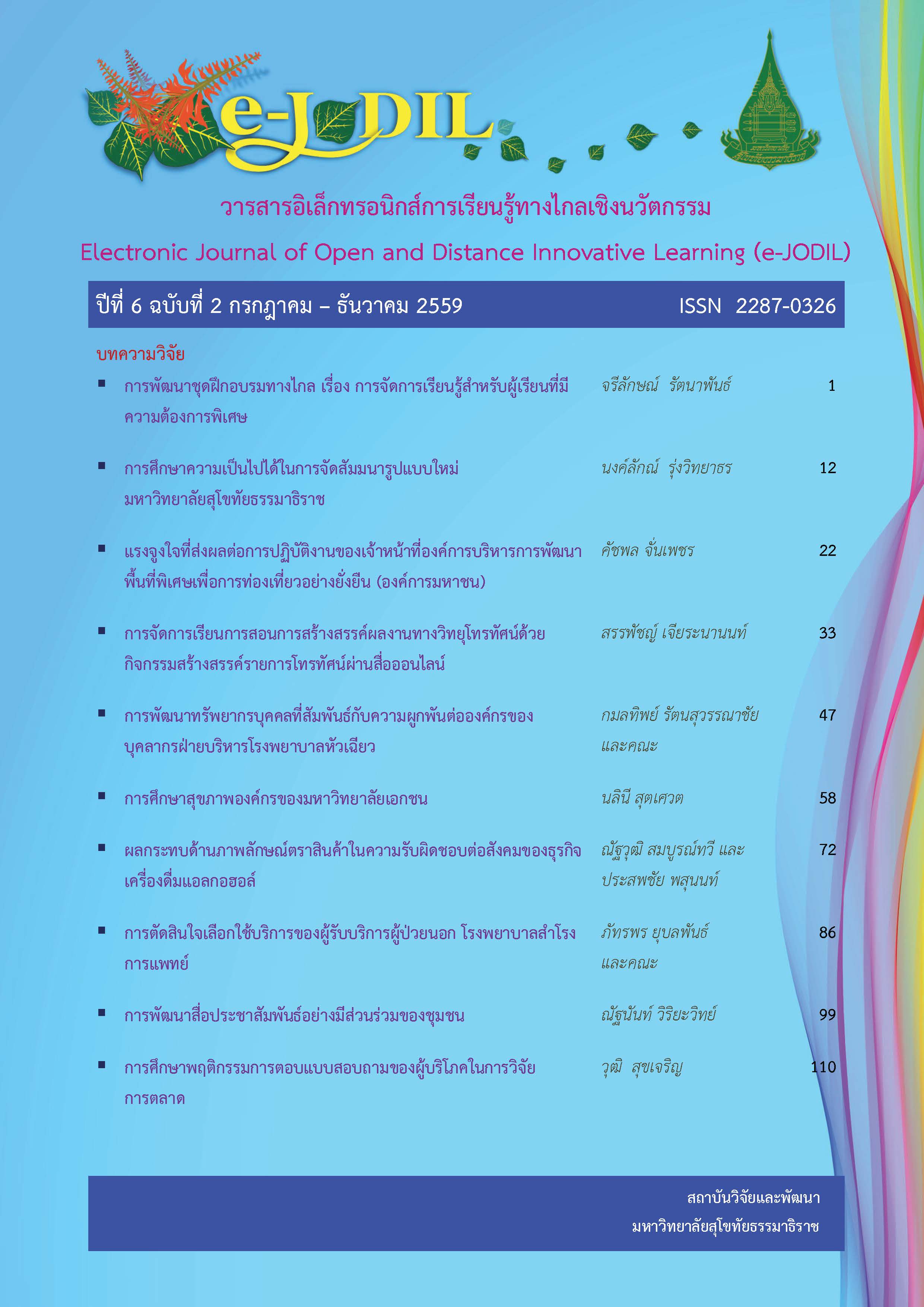การศึกษาพฤติกรรมการตอบแบบสอบถามของผู้บริโภคในการวิจัยการตลาด
Main Article Content
บทคัดย่อ
การวิจัยการตลาดเป็นวิธีหนึ่งที่มีประสิทธิผลเพื่อให้ทราบถึงข้อมูล ช่วยให้นักการตลาดเข้าใจสภาพแวดล้อมทางการตลาด ช่วยค้นหาโอกาสใหม่ ๆ และสามารถระบุถึงปัญหาทางด้านการตลาด การเก็บข้อมูลสำหรับการวิจัยการตลาดนักวิจัยนิยมใช้แบบสอบถามที่ให้ผู้บริโภคตอบด้วยตนเอง คุณภาพของข้อมูลจึงเป็นสิ่งสำคัญที่กำหนดความถูกต้องของข้อค้นพบจากการวิจัย นักวิจัยจึงคาดหวังให้ผู้ตอบแบบสอบถามตอบอย่างซื่อสัตย์
การวิจัยครั้งนี้มีวัตถุประสงค์ 3 ประการ ได้แก่ 1) เพื่อศึกษาพฤติกรรมผู้บริโภคในการตอบแบบสอบถาม 2) เพื่อศึกษาความสัมพันธ์ระหว่างปัจจัยภายในกับการตอบแบบสอบถามให้สมบูรณ์ 3) เพื่อศึกษาความสัมพันธ์ระหว่างปัจจัยภายนอกกับการตอบแบบสอบถามให้สมบูรณ์ การวิจัยในครั้งนี้เก็บข้อมูลจากกลุ่มตัวอย่างจำนวน 400 ตัวอย่าง การวิจัยมีข้อค้นพบสำคัญ ได้แก่ 1) ร้อยละ 88.2 ของผู้บริโภคระบุว่ามีเจตนาที่จะตอบแบบสอบถามแบบออนไลน์ให้สมบูรณ์ และร้อยละ 86.9 ระบุว่ามีเจตนาที่จะตอบแบบสอบถามแบบเก็บซึ่งหน้าให้สมบูรณ์ 2) ปัจจัยภายในมีความสัมพันธ์เชิงบวกกับการตอบแบบสอบถามให้สมบูรณ์ 3) ปัจจัยภายนอกมีความสัมพันธ์เชิงบวกกับการตอบแบบสอบถามให้สมบูรณ์
Downloads
Article Details
บทความ ข้อความ ภาพประกอบ ตารางประกอบ ที่ตีพิมพ์ในวารสารเป็นความคิดเห็นและความรับผิดชอบของผู้เขียนแต่เพียงผู้เดียว ไม่เกี่ยวข้องกับมหาวิทยาลัยสุโขทัยธรรมาธิราชแต่อย่างใด
บทความที่เสนอพิจารณาในวารสาร e-JODIL ต้องเป็นบทความที่ไม่เคยส่งไปลงพิมพ์ เผยแพร่ หรืออยู่ระหว่างการพิจารณาของวารสารอื่น
กองบรรณาธิการขอสงวนสิทธิ์ในการพิจารณาและตัดสินการตีพิมพ์บทความในวารสาร
เอกสารอ้างอิง
Bonke, J. & Fallesen, P. (2009). The Impact of Incentives and Interview Methods on Response Quantity and Quality in Diary- and Booklet-based Surveys. Odense: University press of southern.
DePaulo, P. (2000). Sample Size for Qualitative Research. Retrieved November 28, 2015, from http://www.quirks.com/articles/a2000/20001202.aspx?searchID=38577919
ESOMAR. (2014). Global Market Research 2014. Amsterdam: ESOMAR.
Gendall, P., Leong, M., & Healey, B. (2005). The Effect of Prepaid Non-monetary Incentives in Mail Surveys. Proceedings of ANZMAC 2005 Conference: Marketing Research and Research Methodologies. (pp. 21-27). Perth: University of Western Australia.
Hansen, K. M. (2006). The Effects of Incentives, Interview Length, and Interviewer Characteristics on Response Rates in a CATI-Study. International Journal of Public Opinion Research. 9(1), 112-121.
Hoyer, W.D., & Macinnis, D. J. (2010). Consumer Behavior (5th ed.). Ohio: South-Western Cengage Learning.
Richie, J., Lewis, J., & Elam, G. (2003). Designing and Selecting Samples. In Ritchie, J., and Lewis, J. (Eds.), Qualitative Research Practice: A Guide for Social Science Students and Researchers. (pp. 77-108). London: Sage.
Singer. E. (2012). The Use and Effectives of Incentives in Surveys. Presented at The National Science Foundation. Washington DC, October 3-4.
Zikmund, W. G. & Babin, B. J. (2010). Exploring marketing research. (10th ed.). Australia: South-Western.


